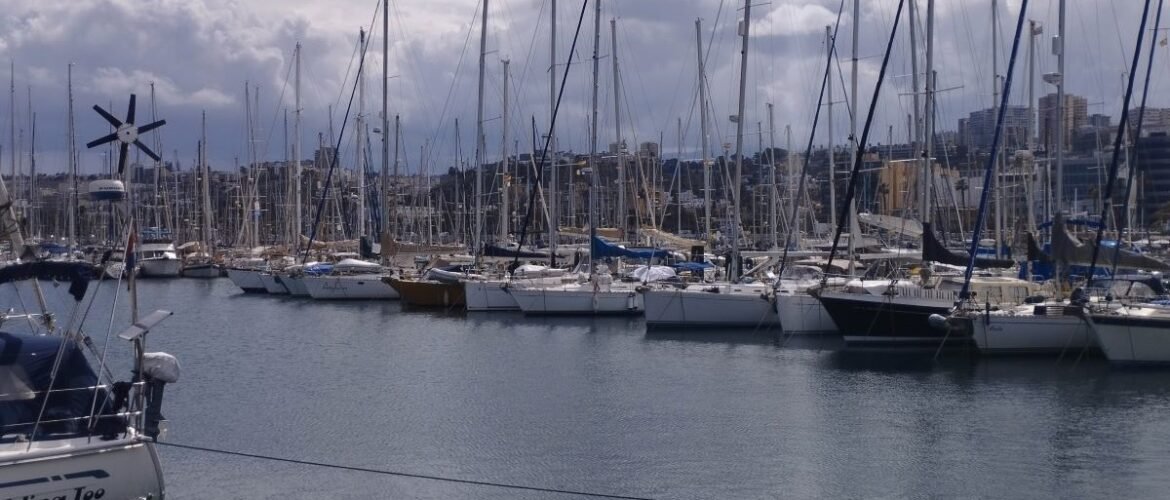What next for Emerald and our ongoing adventures, now that we’d escaped Porto Santo?
Having spent the last 20 months stationery, you’d think we would be raring to go, exploring the anchorages and harbours around the Canary Islands. Well, we are raring to go, but, practicality has sadly trumped sea adventures and we’ve taken a berth in the marina at Las Palmas de Gran Canaria for a couple of months.
Wait, What? You’re Stopping Again?
We didn’t really want to stop, but with a long list of repairs, renewals and upgrades, it seemed the sensible thing to do. It would then make our future adventures more enjoyable and very importantly, safer.
The major repair is for the foresails, both of which need their UV strip replacing. Some of the boat’s safety gear requires updating or renewal. It made sense to do the work in Las Palmas, while there was easy opportunity. Plus there’s Colin’s solar upgrade, which he’s been planning since the winter in the Rio Guadiana.
We could have ordered some of the items for delivery to Porto Santo, but always with an uncertainty around delivery. In Las Palmas, the bright lights of the big city were calling with it’s plethora of chandlers, hardware stores, and services. Being able to wander the shops and browse was a temptation that we struggled to resist. Plus, to then have items immediately to hand, that was the clincher.
We also have life admin to attend to and family visits to make. A change in flight schedules in Madeira has made a journey to the UK more complicated and costly. Whereas in the Canary Islands, the options are plentiful and more kindly on our finances, particularly at this time of year.

Why Las Palmas?
We’d chosen Las Palmas de Gran Canaria marina as our preferred base, based on cost and practicality.
Las Palmas marina is one of the lowest cost harbours in the Canary Islands archipelago. The downside: they don’t take bookings. Instead, the marina allocates berths as they become available. On arrival, a boat’s crew go to register with the harbour office. Most often, the marinero adds the boat to a wait list. The boat then anchors in the adjacent anchorage, on standby to receive a message saying that there is a place available. But, no one really knows how movement up the list works. Some say it depends on the length of your stay, the shorter, the better. But that wasn’t the case for us. Others say it depends on the size of boat and available berths. In reality, there’s a large amount of luck and being in the right place at the right time that determines how long you’ll wait.
Low Cost But Popular
Las Palmas is a large marina, with over 200 visitor berths. Between September to mid-November the majority of visitor places are allocated to the Atlantic Rally for Cruisers (ARC) boats. The anchorage subsequently becomes busy with waiting non-ARC boats, many of those also planning an Atlantic crossing. Then, even after the ARC has departed, places don’t come easy and there can still be a wait to get a berth.
The area is a lot quieter at this time of year (March), with the majority of boats having left for adventures across the pond. However, there are yachts still cruising the islands, and we knew that boats were still waiting in the anchorage, although we later learnt that some of those boats prefer to be at anchor than inside. We didn’t mind a short wait, but to add to our peril, the anchorage closes on the 15th March, a week after our arrival, until September. After that, there is no longer a place to wait.

Lack of Sleep Induced Paranoia
Logic and reason are some of the first casualties of sleep deprivation. For the last two thirds of our passage south, I’d convinced myself that we wouldn’t get a space.
What made us so keen on Las Palmas? There are other marinas on the other islands, also with shops and ship chandlers. But none of them fit the bill for us, quite so much as Las Palmas.
Will There Be a Space for Us?
When we went by dinghy to check in the next day, the friendly marinero informed us that unfortunately there wasn’t a space for us and that we’d have to go on the waiting list. We could see the list on the table in front of us, with at least ten other boats on it. Our spirits sagged. But, a minute later the marinero gave us news that lit a spark under those spirits: there could be a space for us. We waited anxiously, whilst a rapid Spanish conversation between staff took place that was too quick for me to follow. We didn’t dare celebrate until the place was definite. Then it was confirmed, we were in! Muchas gracias Las Palmas!
We returned to Emerald, stowed the dinghy on deck and prepared her for marina life with fenders and mooring lines.
We’re always a little terrified of manoeuvring in the close confines of a marina. There are so many perils including tight spaces, other boats, and mooring lines to not get tangled in. Then throw in a boat that doesn’t go backwards in a straight line. Emerald always veers off to one side, and even though we plan for it, it just never seems to work. But in this marina, a mooring service is provided as standard. A RIB met us as we entered the marina and led us to our berth.

A Happy Ending
Once adjacent to our spot, I lined Emerald up as best I could to reverse in, then the RIB gently nudged Emerald’s bow around to finish the job. Our new neighbours on Asylum helped fend off on their side, then, after a brief pulse of astern, I went out to ease her in on the starboard side. Colin was at the stern, ready to pass the mooring lines to a waiting marinero.
Emerald was in, securely tied up and all without any drama. Even better, it had happened in less than a day after arrival. What a very happy ending to our sail south.
We Thought We’d Never Have to Med-Moor Again!
Med-mooring is a method of tying up in a marina, common in the Mediterranean. Boats typically lay stern-to a pontoon, with a mooring line from each aft quarter to cleats on the pontoon. The bow is held in place by lines down to anchoring points on the seabed.
When not in use, the bow lines lie on the seabed, tied between a cleat on the pontoon and the anchor point. To secure a boat, first the lines are hooked up from the pontoon end. Next, they’re fed forward to the bow. This is the messy part, where the line is passed hand to hand along the length of the boat. At the bow, the line is fed through a fairlead before being pulled in tight and secured around a bow cleat.
Sailors call them slime lines. The lines spend most of their lives underwater and become a target for marine growth, hence the slime. If you’re unlucky, some shellfish will have taken up residence on the line too. The rough shells can cause nasty cuts on the hands of the unwary as the lines are fed along.
For this reason we always wear a pair of thick gardening gloves and old clothes, because there’s bound to be something slimy or dirty that flicks off and lands on you as you manhandle the line awkwardly around the rigging and fenders from stern to bow.
When we left the Med, we thought that we’d never have to Med moor again.

Walking The Plank
Another feature of Med-mooring is the plank which allows access to the boat from the pontoon. Some people have very fancy passerelles, some which fold and the fanciest ones even have hand rails. We managed during our the time in the Med with a homemade plank, the fanciest part of which was Emerald’s name painted on it in green. However, when we knew that we were leaving the Med, we donated it to another cruiser.
With this in mind, it genuinely surprised us to see a boarding plank on a friend’s photo of Las Palmas marina. So, while waiting for launch during our recent visit to Porto Santo’s boatyard, we scavenged some waste planks of wood, and repurposed them into “The Plank Mk II”.

The Solar Upgrade
Colin has been planning a solar upgrade since we wintered in the Rio Guadiana in 2020. Then, during Emerald’s lift-out in Porto Santo, a panel was accidentally smashed, reducing our capacity.
The time to buy solar is certainly right right now, with the price of panels ridiculously low in the DIY stores. There are 420W, 500W and even 550W panels available, all for under €100 each. Compare that to when we first bought panels in 2004, when our 75W panels cost approx. €100 each. The efficiency of solar technology has also vastly improved since then, making the purchase of new panels a no-brainer.

Settling in to Marina Life
We much prefer to be at anchor over squeezing in amongst other boats in a marina. But, marina life does have its benefits. Water and power are right at hand and getting ashore is a breeze.
The main thing that we dislike is the noise that comes with being in a big city. A very close second is being amongst so many other boats and people. But Las Palmas marina has surprised us in a good way. Despite the several lane highway that runs along the edge of the marina, we can hear hardly any road noise on pontoon R. Certainly not enough that it registers. Plus, there is barely any noise from our pontoon-mates too. Long may it continue!
So far we’ve joined in with a Friday evening sailors’ get together and caught up with friends that we made in Porto Santo. Another pleasant surprise is that Gran Canaria has so many hiking trails. We’ve managed to squeeze in a few land based adventures whilst juggling our available time with the important boat jobs. With so much to do, our time here is going to be very busy!

What Next for Emerald Once the Jobs are Complete?
So all added up, staying put for a couple of months seemed the sensible thing to do. We’d be able to get the important fixes done while taking advantage of the convenient shops and services. Plus, amongst the boat jobs, there is the prospect of some adventures, with a new island for us to explore.
If we can finish everything in that time, we’ll be well set up for future sailing. We really hope that idyllic anchorages feature more prominently in Emerald’s future than boatyards! Of course, there will always be ongoing boat maintenance and repairs but we’d really like to spend more of our time exploring than fixing things.
The Social Media Bit: Want to Follow Us?
If you’d like to follow us on other social media platforms (Facebook, Instagram and YouTube), you can do so by using these links:
Or use the link below to track our voyage on NoForeignLand.com.
And finally, you can sign up to receive email notifications of new blogs using the subscribe box at the bottom of this page.
Thank you from Nichola & Colin



Thanks as always for a great update with numerous details that are helpful for those of us that are coming to the Canary Islands at the end of this year. Definitely understand not wanting to be tied up in a marina again, but looks like there have been definite benefits with the upgrades you are doing as well as getting in some hiking. Making it into a positive is always good! All the best to you both